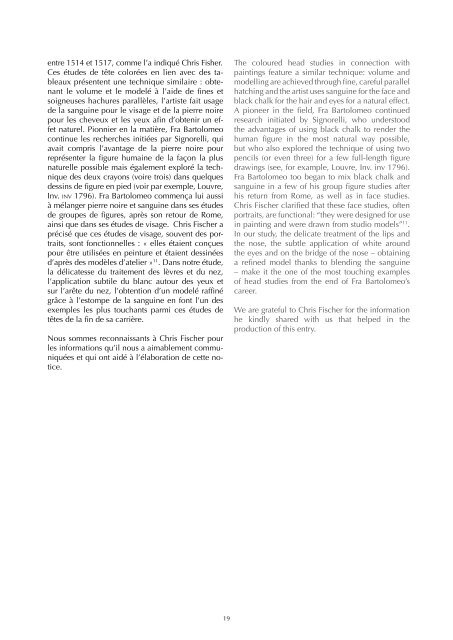Create successful ePaper yourself
Turn your PDF publications into a flip-book with our unique Google optimized e-Paper software.
entre 1514 et 1517, comme l’a indiqué Chris Fisher.<br />
Ces étu<strong>de</strong>s <strong>de</strong> tête colorées en lien avec <strong>de</strong>s tableaux<br />
présentent une technique similaire : obtenant<br />
le volume et le mo<strong>de</strong>lé à l’ai<strong>de</strong> <strong>de</strong> fines et<br />
soigneuses hachures parallèles, l’artiste fait usage<br />
<strong>de</strong> la sanguine pour le visage et <strong>de</strong> la pierre noire<br />
pour les cheveux et les yeux afin d’obtenir un effet<br />
naturel. Pi<strong>on</strong>nier en la matière, Fra Bartolomeo<br />
c<strong>on</strong>tinue les recherches initiées par Signorelli, qui<br />
avait compris l’avantage <strong>de</strong> la pierre noire pour<br />
représenter la figure humaine <strong>de</strong> la faç<strong>on</strong> la plus<br />
naturelle possible mais également exploré la technique<br />
<strong>de</strong>s <strong>de</strong>ux cray<strong>on</strong>s (voire trois) dans quelques<br />
<strong>de</strong>ssins <strong>de</strong> figure en pied (voir par exemple, Louvre,<br />
Inv. inv 1796). Fra Bartolomeo commença lui aussi<br />
à mélanger pierre noire et sanguine dans ses étu<strong>de</strong>s<br />
<strong>de</strong> groupes <strong>de</strong> figures, après s<strong>on</strong> retour <strong>de</strong> Rome,<br />
ainsi que dans ses étu<strong>de</strong>s <strong>de</strong> visage. Chris Fischer a<br />
précisé que ces étu<strong>de</strong>s <strong>de</strong> visage, souvent <strong>de</strong>s portraits,<br />
s<strong>on</strong>t f<strong>on</strong>cti<strong>on</strong>nelles : « elles étaient c<strong>on</strong>çues<br />
pour être utilisées en peinture et étaient <strong>de</strong>ssinées<br />
d’après <strong>de</strong>s modèles d’atelier » 11 . Dans notre étu<strong>de</strong>,<br />
la délicatesse du traitement <strong>de</strong>s lèvres et du nez,<br />
l’applicati<strong>on</strong> subtile du blanc autour <strong>de</strong>s yeux et<br />
<str<strong>on</strong>g>sur</str<strong>on</strong>g> l’arête du nez, l’obtenti<strong>on</strong> d’un mo<strong>de</strong>lé raffiné<br />
grâce à l’estompe <strong>de</strong> la sanguine en f<strong>on</strong>t l’un <strong>de</strong>s<br />
exemples les plus touchants parmi ces étu<strong>de</strong>s <strong>de</strong><br />
têtes <strong>de</strong> la fin <strong>de</strong> sa carrière.<br />
Nous sommes rec<strong>on</strong>naissants à Chris Fischer pour<br />
les informati<strong>on</strong>s qu’il nous a aimablement communiquées<br />
et qui <strong>on</strong>t aidé à l’élaborati<strong>on</strong> <strong>de</strong> cette notice.<br />
The coloured head studies in c<strong>on</strong>necti<strong>on</strong> with<br />
paintings feature a similar technique: volume and<br />
mo<strong>de</strong>lling are achieved through fine, careful parallel<br />
hatching and the artist uses sanguine for the face and<br />
black chalk for the hair and eyes for a natural effect.<br />
A pi<strong>on</strong>eer in the field, Fra Bartolomeo c<strong>on</strong>tinued<br />
research initiated by Signorelli, who un<strong>de</strong>rstood<br />
the advantages of using black chalk to ren<strong>de</strong>r the<br />
human figure in the most natural way possible,<br />
but who also explored the technique of using two<br />
pencils (or even three) for a few full-length figure<br />
drawings (see, for example, Louvre, Inv. inv 1796).<br />
Fra Bartolomeo too began to mix black chalk and<br />
sanguine in a few of his group figure studies after<br />
his return from Rome, as well as in face studies.<br />
Chris Fischer clarified that these face studies, often<br />
portraits, are functi<strong>on</strong>al: “they were <strong>de</strong>signed for use<br />
in painting and were drawn from studio mo<strong>de</strong>ls” 11 .<br />
In our study, the <strong>de</strong>licate treatment of the lips and<br />
the nose, the subtle applicati<strong>on</strong> of white around<br />
the eyes and <strong>on</strong> the bridge of the nose – obtaining<br />
a refined mo<strong>de</strong>l thanks to blending the sanguine<br />
– make it the <strong>on</strong>e of the most touching examples<br />
of head studies from the end of Fra Bartolomeo’s<br />
career.<br />
We are grateful to Chris Fischer for the informati<strong>on</strong><br />
he kindly shared with us that helped in the<br />
producti<strong>on</strong> of this entry.<br />
19















